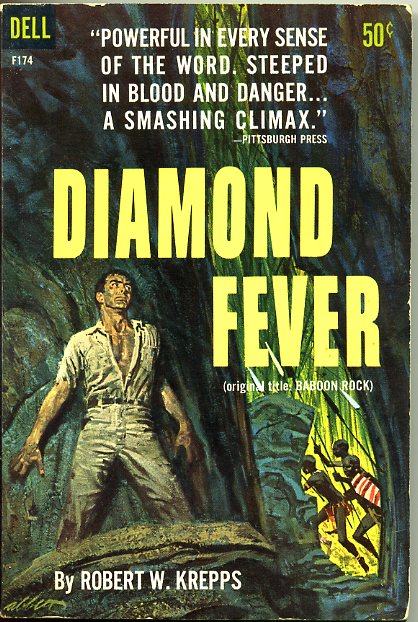
"Prices vary somewhat with different publishers. One practice that may cause an artist trouble is that of offering an over-all fixed price for a jacket or book illustration regardless of its complexity or the amount of preliminary work required."
"There is considerable prestige and publicity in bookjacket and book-illustration work, particularly the latter, because the title page of the book gives credit to the artist. Artists should always sign jackets, and many publishers repeat the artist's name on the jacket's inside flap."
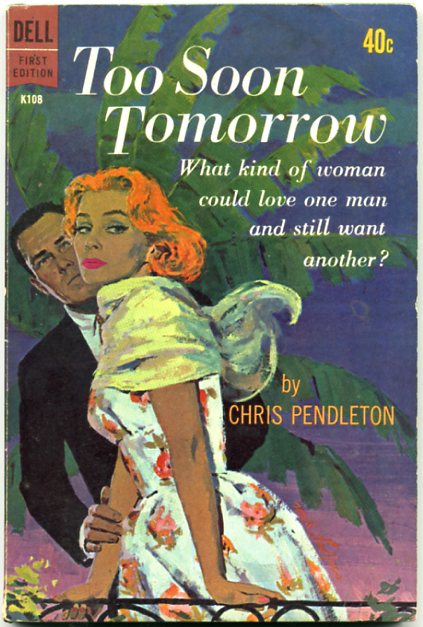
Recently, Mitchell Hooks explained to us that paperback covers went for about $300 when he began doing them in the early 50's and that as a member of the Graphic Artists Guild he worked to encourage publishers to pay better rates. After a few years, the average cover was going for $800.
Harry Borgman, who painted the cover below, told me the following from his own experience illustrating book covers:
"I did a few paperbacks from 1965 to 1973, probably a total of 12 or 15. For most of them I was paid $900, the first ones were a bit lower."
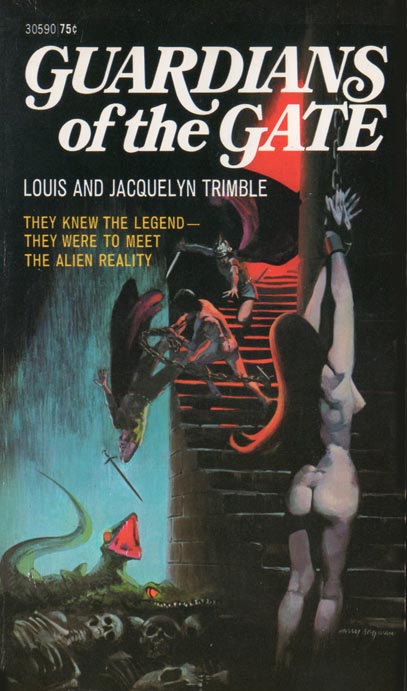
This is not an area I have any experience with, so I asked my friend René Milot how much he has been paid in recent years for book covers. René tells me that he has received as much as $5,000 for a cover from a major publisher... but that price has actually dropped in the last few years. $2,500 to $3,500 is now more typical, as publishers, like all purveyors of 'analog' media, struggle with diminished markets in a digital world. Still, compared to other traditional areas of illustration, I'd say that not only do books remain a safe-haven for literal, painterly illustrators, they also seem to pay relatively well.
Children's book publishing is another market that seems to continue to provide opportunities for the artist. While financial success in children's books can be hit-and-miss, those shortcomings might be offset by the potential for personal expression and artistic experimentation.
Rodewald writes, "Very frequently, especially in the case of children's books, a publisher will offer the artist a share of the royalties on the book. A contract also provides for an advance against royalties ranging from a few to several hundred dollars, depending on the estimated sales of the book."
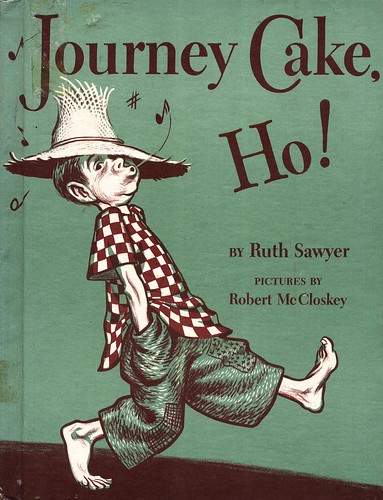
"The royalty is based on a percentage of the wholesale price of the book, and of this the artist will get his percentage, which varies depending on the arrangement between the author and artist. Sometimes, when the art work in a children's book is as essential as the text, the artist is viewed as a collaborator, and the royalty rate is split between artist and author on equal or near equal terms."
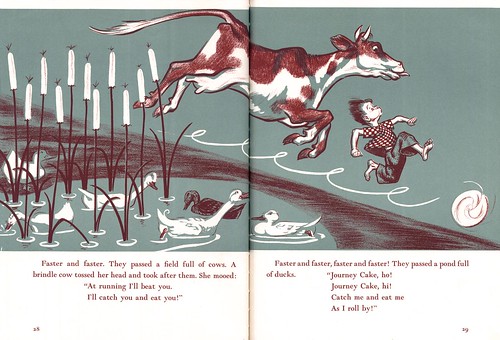
"The rates of royalties in book work, as well as flat fees, differ widely from case to case, and each must be judged on its merits."
*Once again I must sing the praises of 5m@5hYdez, whose paperback cover archives are a visual feast the likes of which cannot be found anywhere else on the internet.
* Thanks also to Harry Borgman and René Milot for providing information for this post.
We stumbled upon a remaindered copy of Journey Cake, Ho! back in the '80s and bought it on the strength of McCloskey's illustrations. It became one of my kids' and my favorite books.
ReplyDeleteSounds much like my own experience, j auclair - that spread I showed here with the leaping cow just bowled me over!
ReplyDelete(But I'm a McCloskey fan from waaaay back anyway)
Bob Abbett is one of my favorite paperback illustrators ever!!! Just and incredible and often overlooked talent!
ReplyDeleteJoe;
ReplyDeleteyou'll love 5m@5hdez's Bob Abbett flickr set: http://www.flickr.com/photos/grrl8trax/sets/72157602976281905/
Ha! I happen to have a copy of that "Guardians of the Gate" paperback from about 30 years ago.
ReplyDeleteRoyalties are nice.
From friends of mine who illustrated covers in the 80's, I got the impression that that was last era when cover assignments were prestigious. By the time the 90s rolled in, mergers had taken place, and the market really dwindled. Publishers who put out 75 titles a year would merge with another company who had similar output, but when they formed the new company, instead of 150 titles going out, there would be 85. There is a lot of competition for those 85 slots!
ReplyDeleteThe bright side is that the need for the art isn't going away. A few years back Avon Nova books shut down to "remake" themselves. When they came back as Avon Eos books, they had done away with cover art, and had replaced it with abstract designs created by staff members on the computer. Their sales were awful. They quickly scrambled and hired artists to do new covers and re-released the books, and sales picked up again. Unfortunately, I don't think Avon Eos pays more than $2000 a cover, since all of their books are reprints, and they try to keep costs down.
I have friends who have done 500 covers between the two of them and who turned down work in the 80s because they had too much to do, but could not get a single cover by the beginning of this century. They ended up leaving illustration.
Young Adult books are probably a better genre to work in than most. There always seems to be a lot of YA books on the shelves.
Romance pays probably the best, from what I've heard, because artists aren't eager to do the assignments (they get sick of the same old clinches painting after painting).
The best place to be, to me, is writing and illustrating your own children's books. You get paid for both job titles, have more control over your work, and the potential income is better. (ask James Gurney or Tony DiTerlizzi).
Murray Tinkleman, who was one of my illustration teachers, now offers a graduate program in CT, but the emphasis has changed in the class. Students are taught to be entrepreneurs and to generate their own work now that the field has changed so much.
Illustration ain't so golden anymore.
Re: Innisart's comment: and yet go into your local Chapters or similar and the amount of illustration on book covers is remarkable. Not all to my taste, but the field seems healthy enough.
ReplyDeleteRe: that earlier post with the photo of the group could be right out of Madmen!
All the Nearly Anonymous artwork is great. We have all flipped through old magazines marvelling at such stuff, but kudos to you for taking it all to the next level by spotlighting all these guys and diging up all the extra info.
Keep up the good work.
innisart; thanks for your insightful overview of the recent developments in the book industry - I'm sure that's extremely helpful information for a lot of young artists coming up, not to mention those who are making a living (or trying to) in the business today.
ReplyDeleteChildren's books are, to me, a huge gamble. The investment in time is massive, and when you finally successfully get a book into the marketplace, its almost like winning the lottery if you actually get noticed and start selling any kind of volume.
Of course if you DO get noticed, the rewards can be huge - case in point, your examples.
SWEET!!! Thanks, Leif!!!
ReplyDeleteA little late, but I thought I'd add my 2 cents regarding Children's Books...
ReplyDeleteAt ICON5 this year Leonard Marcus spoke about the field of Children's Book illustration (http://theillustrationconference.org/sessions.html#whatdo), and had a lot of insightful information... there's still a lot of work to be had in this subgenre - and the best way to get noticed is to create, write, and illustrate your own book!
Leif, I agree that it's a lot of work, and not every illustrator has an idea for a kid's book... but the payoff isn't so much in the sales, but in the notice you'll get from editors and publishers.. who will then send work your way on other projects.
The thing is that editors are constantly bombarded with submissions... writers' stories that need artists and vice versa... if you can give them the whole package - writing and illustration - so all they have to do is layout, and send to the printers... it's less of a risk for the publisher. Or better yet, do the graphic design and print it yourself - if you have the tools and know-how!